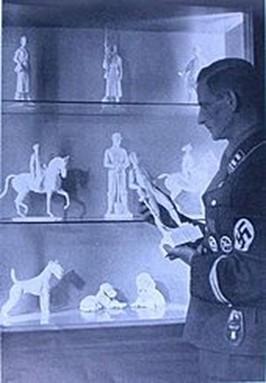 From German Art Gallery
From German Art Gallery
Ottmar Obermaier (1883–1965) was born in Inzzell, Bavaria. In 1907 he went to Akademie der Bildende Kunsten in Munich, where he studied under Professor Erwin Kurz, who at that time was a famous teacher and sculptor of statues. Obermaier’s works were frequently displayed in the Glaspalast in Munich. From 1923 on he worked as a designer for Rosenthal Porcelain. Rosenthal hired Obermaier to design idealized human forms based on Greek and Roman classics for production. These figures, most displaying physical prowess and athletic pursuits, have titles such as Discus Thrower, Victor, and Striding Woman. Ottmar Obermaier represented Germany in 1928 at the Amsterdam Olympics. While Obermaier did not medal in the 1928 Olympics, he continued to design for Rosenthal until the mid-1930s. After 1936 he also worked as a designer for the Allach porcelain manufactory. Obermaier was represented in the Great German Art Exhibitions with 13 works, of which two were bought by Hitler. His most well known sculptures were ‘Deutsche Mutter’, ‘Der Sieger’, ‘Die Siegerin’, ‘Meister im Wurf’, ‘Schreitendes’ and ‘Jung Deutschland’. Obermaier died in 1965 in Munich.
Allach Porcelain
 The Allach porcelain manufactory was established in 1935 by Master of ceramics Franz Nagy and his business partner, the porcelain artist Prof. Karl Diebitsch Obersturmbannführer in the Waffen-SS). In 1936 the factory, which was based in the small town of Allach, near Munich, was acquired by Heinrich Himmler, the leader of the SS. The acquisition of a fine porcelain factory was a way to establish an industrial base for the production of works of art that would be representative of the truly Germanic culture. The emphasis was on decorative ceramics. The company logo included stylized SS runes. High-ranking artists were locked into contract: Karl Diebitsch, Prof. Theodor Kärner, Richard Förster, Ottmar Obermaier, Prof. Benno von Arndt, Prof. Wilhelm Krieger, Prof. Willy Zügel, Adolf Röhrig, Wilhelm Neuhäuser and others. The product range of the factory included over 240 porcelain and ceramic models. The quality of the porcelain pieces produced at Allach was extraordinary. As output at the Allach factory increased, the Nazis moved production to a new facility near the Dachau concentration camp. The factory made use of a pool of slave labour provided by the Dachau camp….
The Allach porcelain manufactory was established in 1935 by Master of ceramics Franz Nagy and his business partner, the porcelain artist Prof. Karl Diebitsch Obersturmbannführer in the Waffen-SS). In 1936 the factory, which was based in the small town of Allach, near Munich, was acquired by Heinrich Himmler, the leader of the SS. The acquisition of a fine porcelain factory was a way to establish an industrial base for the production of works of art that would be representative of the truly Germanic culture. The emphasis was on decorative ceramics. The company logo included stylized SS runes. High-ranking artists were locked into contract: Karl Diebitsch, Prof. Theodor Kärner, Richard Förster, Ottmar Obermaier, Prof. Benno von Arndt, Prof. Wilhelm Krieger, Prof. Willy Zügel, Adolf Röhrig, Wilhelm Neuhäuser and others. The product range of the factory included over 240 porcelain and ceramic models. The quality of the porcelain pieces produced at Allach was extraordinary. As output at the Allach factory increased, the Nazis moved production to a new facility near the Dachau concentration camp. The factory made use of a pool of slave labour provided by the Dachau camp….
Olympic Games
In 1928, the modern Olympic Games included art competitions in addition to the athletic contests. Medals were awarded for exhibits of town planning, architecture, drama, poetry, music, graphic arts and paintings as well as sculpture, reliefs and medallions. Ottmar Obermaier, at that time a designer for Rosenthal, represented Germany in 1928 at the Amsterdam Olympics (art competitions in the Olympic Games were abandoned after 1948. Organizers felt that the artists were professionals, negating the amateur ideal of the games).
Source Article from http://www.renegadetribune.com/ottmar-obermaiers-sculptures-physical-prowess-athletic-pursuits-beauty/
 RSS Feed
RSS Feed















 September 22nd, 2017
September 22nd, 2017  Awake Goy
Awake Goy 
 Posted in
Posted in  Tags:
Tags: 













